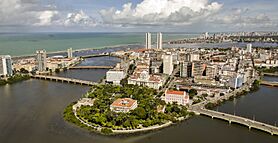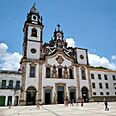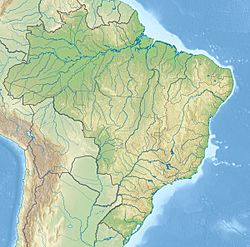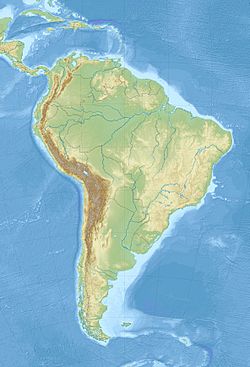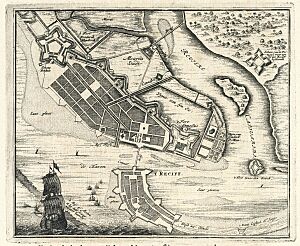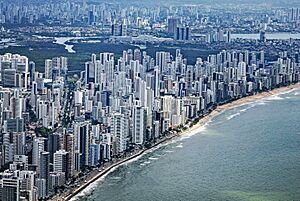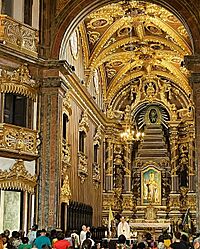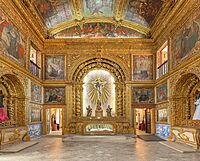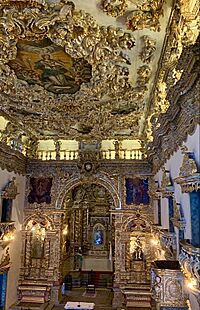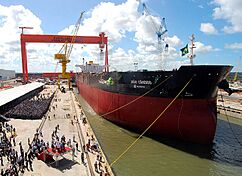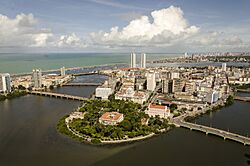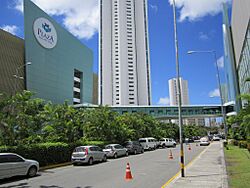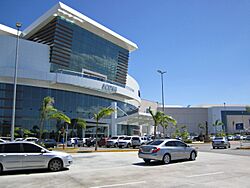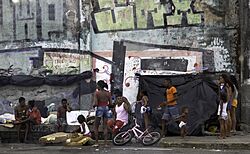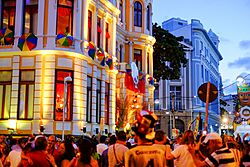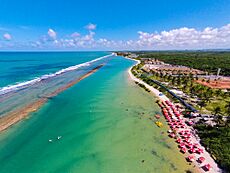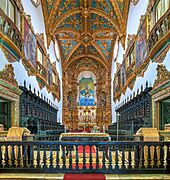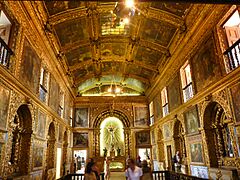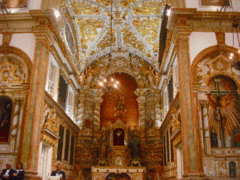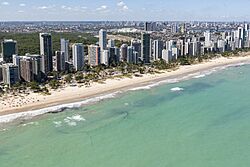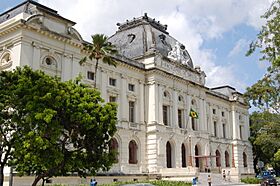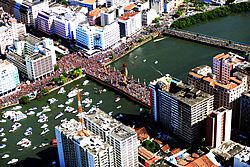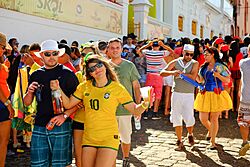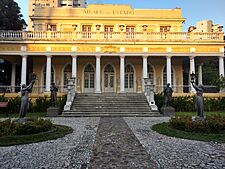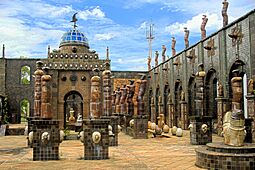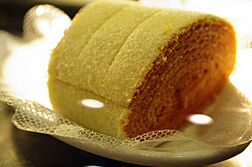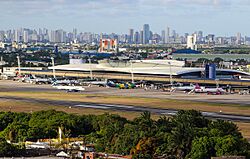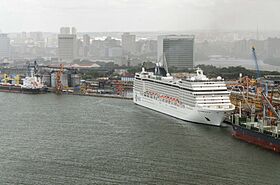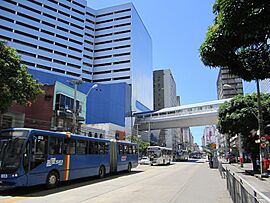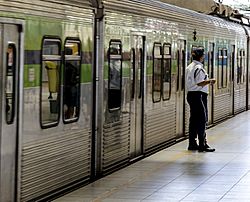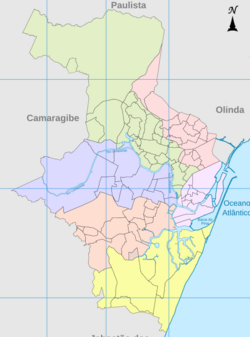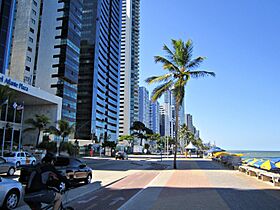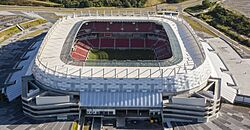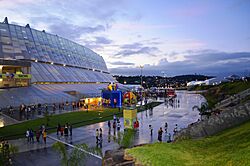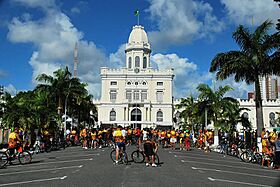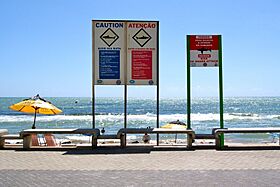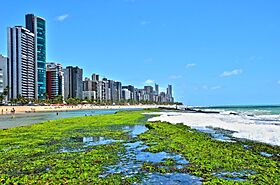Recife facts for kids
Quick facts for kids
Recife
|
|||
|---|---|---|---|
|
Municipality
|
|||
| Municipality of Recife | |||
|
Skyline of Recife with Antônio Vaz Island and the bridges of the Historic Center
Crystal Tower
Basilica of Recife
Brennand Castle
Rio Branco Square
Boa Viagem
Aurora Street
|
|||
|
|||
| Nickname(s):
Veneza Brasileira (Brazilian Venice), Capital of the Northeast and Mauricéia/Mauritsstad (after the Dutch colonisation)
|
|||
| Motto(s): | |||

Location in the state of Pernambuco
|
|||
| Country | |||
| Region | Northeast | ||
| State | Pernambuco | ||
| Founded | 12 March 1537 | ||
| Incorporated (as village) | 1709 | ||
| Incorporated (as city) | 1823 | ||
| Area | |||
| • Municipality | 218 km2 (84.17 sq mi) | ||
| • Metro | 2,768 km2 (1,068.7 sq mi) | ||
| Elevation | 10 m (33 ft) | ||
| Population
(26/08/2024)
|
|||
| • Municipality | 1.653.461 (9th) | ||
| • Density | 6,803.6/km2 (18,537.9/sq mi) | ||
| • Metro | 4,305,000 (6th) | ||
| • Metro density | 1,352.5/km2 (3,527/sq mi) | ||
| Demonym(s) | Recifense | ||
| GDP (PPP, constant 2015 values) | |||
| • Year | 2023 | ||
| • Total (Metro) | $47.2 billion | ||
| • Per capita | $11,300 | ||
| Time zone | UTC-03:00 (BRT) | ||
| Postal code |
50000-001 to 52999-999
|
||
| Area code | +55 81 | ||
| HDI (2010) | 0.772 – high | ||
Recife is a big city in Brazil. It is the capital of the state of Pernambuco. You can find it on the northeastern Atlantic coast of South America. It is the largest city in Pernambuco and one of the biggest urban areas in Brazil.
Recife was started in 1537. It became an important port for the area, especially for growing sugar cane. For a while in the 1600s, it was even called Mauritsstad. This was when the Dutch West India Company ruled it as part of Dutch Brazil.
The city gets its name from the stone reefs just off its coast. Recife is built where the Beberibe and Capibaribe rivers meet the ocean. It has many small islands and over 50 bridges. This makes it feel like a "river city" or "Venice of Brazil."
Recife is a major industrial area. It makes things like sugar, cars, ships, and electronics. It is also a very important place for business and trade in Brazil's Northeast. Many hospitals with modern equipment are here, making it a big medical center.
The city is a popular place for tourists. People come to see its beaches, like Porto de Galinhas, and its historic sites. The nearby city of Olinda is a UNESCO World Heritage Site. Both cities are famous for their Brazilian Carnival celebrations. Recife is also a center for education, with the Federal University of Pernambuco being a large university there.
Recife has hosted big sports events, including games for the 2014 FIFA World Cup.
Contents
History of Recife
![]() Portuguese Empire 1537–1630
Portuguese Empire 1537–1630
![]() Dutch West India Company 1630–1654
Dutch West India Company 1630–1654
![]() Portuguese Empire 1654–1815
Portuguese Empire 1654–1815
![]() United Kingdom of Portugal, Brazil and the Algarves 1815–1822
United Kingdom of Portugal, Brazil and the Algarves 1815–1822
![]() Empire of Brazil 1822–1889
Empire of Brazil 1822–1889
![]() Republic of Brazil 1889–present
Republic of Brazil 1889–present
Recife started as a small group of fishing huts and warehouses. This was between 1535 and 1537. It was a stop for Portuguese sailors and ships. The city's name comes from the "reef of the ships" (arrecife dos navios). This reef runs along the coast and protects the harbor.
In 1541, the first sugar mill was built in Recife. The area around the Capibaribe River was covered with sugar cane fields.
Recife became the capital of Dutch Brazil in the 1600s. The Dutch West India Company called it Mauritsstad. But the Portuguese took the city back in 1654. This happened after important battles called the Battles of Guararapes.
The Mascate War happened in 1710–1711. It was a fight between merchants from Recife and the nearby town of Olinda.
{{wide image|Frederick Hagedorn - Panorama do recife - 1855.jpg|880px|align-cap=center|A wide view of Recife in 1855.]]
Geography and Climate
Recife is close to the equator, so it is usually warm. It has many islands, rivers, and bridges. This is why it is called "The Venice of Brazil." The city is in a tropical forest area. This means it gets a lot of rain. The soil is not very rich because the heavy rain washes away nutrients.
The weather is warm to hot all year. There is also high humidity. But cool ocean breezes help make it more comfortable. January and February are the warmest months. July is the coolest and cloudiest. June is the wettest month, with a lot of rain. November is the driest and sunniest month.
The city of Recife is made up of three islands: Recife, Santo Antônio, and Boa Vista. The Beberibe and Capibaribe rivers flow between these islands.
Recife's Weather Details
| Climate data for Recife (1991–2020, extremes 1961–present) | |||||||||||||
|---|---|---|---|---|---|---|---|---|---|---|---|---|---|
| Month | Jan | Feb | Mar | Apr | May | Jun | Jul | Aug | Sep | Oct | Nov | Dec | Year |
| Record high °C (°F) | 34.7 (94.5) |
34.3 (93.7) |
35.1 (95.2) |
33.5 (92.3) |
33.2 (91.8) |
31.9 (89.4) |
33.1 (91.6) |
32.2 (90.0) |
32.7 (90.9) |
33.2 (91.8) |
33.2 (91.8) |
34.5 (94.1) |
35.1 (95.2) |
| Mean daily maximum °C (°F) | 30.8 (87.4) |
31.0 (87.8) |
30.9 (87.6) |
30.4 (86.7) |
29.6 (85.3) |
28.5 (83.3) |
27.9 (82.2) |
27.9 (82.2) |
28.6 (83.5) |
29.6 (85.3) |
30.4 (86.7) |
30.8 (87.4) |
29.7 (85.5) |
| Daily mean °C (°F) | 27.1 (80.8) |
27.3 (81.1) |
27.2 (81.0) |
26.6 (79.9) |
25.8 (78.4) |
24.8 (76.6) |
24.2 (75.6) |
24.2 (75.6) |
25.2 (77.4) |
26.1 (79.0) |
26.7 (80.1) |
27.1 (80.8) |
26.0 (78.8) |
| Mean daily minimum °C (°F) | 23.1 (73.6) |
23.3 (73.9) |
23.2 (73.8) |
22.8 (73.0) |
22.3 (72.1) |
21.5 (70.7) |
21.0 (69.8) |
20.7 (69.3) |
21.5 (70.7) |
22.4 (72.3) |
22.8 (73.0) |
23.0 (73.4) |
22.3 (72.1) |
| Record low °C (°F) | 16.8 (62.2) |
17.8 (64.0) |
17.9 (64.2) |
17.1 (62.8) |
16.9 (62.4) |
17.1 (62.8) |
16.0 (60.8) |
15.0 (59.0) |
15.0 (59.0) |
16.0 (60.8) |
16.7 (62.1) |
16.4 (61.5) |
15.0 (59.0) |
| Average precipitation mm (inches) | 106.6 (4.20) |
127.0 (5.00) |
197.2 (7.76) |
268.9 (10.59) |
317.1 (12.48) |
390.5 (15.37) |
314.8 (12.39) |
186.7 (7.35) |
93.3 (3.67) |
52.8 (2.08) |
39.0 (1.54) |
61.6 (2.43) |
2,155.5 (84.86) |
| Average precipitation days | 11 | 11 | 15 | 17 | 19 | 22 | 23 | 19 | 12 | 9 | 7 | 8 | 173 |
| Average relative humidity (%) | 73.5 | 74.3 | 76.3 | 80.1 | 83.1 | 84.6 | 83.9 | 81.0 | 77.0 | 73.7 | 71.8 | 71.9 | 77.6 |
| Mean monthly sunshine hours | 222.5 | 204.4 | 220.2 | 203.6 | 189.3 | 164.5 | 173.6 | 195.5 | 207.7 | 233.2 | 243.2 | 244.6 | 2,502.3 |
| Source: Instituto Nacional de Meteorologia | |||||||||||||
People and Culture
Population of Recife
The Recife area is the 5th most populated in Brazil. It is the most populated in the Northeast region. In 2022, there were about 1.5 million people living in the city of Recife.
| Race and ethnicity in Recife | ||||
|---|---|---|---|---|
| Ethnicity | Percentage | |||
| Pardo (Multiracial) | 48.5% | |||
| White | 38.8% | |||
| Black | 12.3% | |||
| Asian | 0.2% | |||
| Amerindian | 0.2% | |||
Most people in Recife are of mixed race (48.5%). About 38.8% are White, and 12.3% are Black. A small number are Asian or Indigenous.
Religions in Recife
The main religion in Recife is Catholicism. The city's special saint is Our Lady of Mount Carmel. Her day is celebrated every year on July 16. Many people in Recife are also Protestant. Some people have no religion, and others follow Spiritist or Afro-Brazilian religions.
| Religion | Percentage (%) | Number |
|---|---|---|
| Catholic Church | 54.32 | 835.337 |
| Protestant | 24.99 | 384.303 |
| No religion | 14.59 | 224.401 |
| Spiritist | 3.56 | 54.788 |
| Other Christian religiosities | 1.59 | 24.474 |
| Umbanda, Candomblé and other Afro-religions | 0.48 | 7.434 |
| Judaism | 0.08 | 1.286 |
| Buddhism | 0.04 | 641 |
| Indigenous traditions | 0.01 | 251 |
| Islam | 0.004 | 69 |
| Hinduism | 0.002 | 38 |
Source: IBGE 2010.
Economy and Business
Recife is a big business center in Brazil. It has an international airport and two international seaports. One port is in the city, and the other, Suape, is about 40 kilometers (25 miles) away.
The area around Recife has many industries. These include shipbuilding, car making, oil refining, and electronics. Many companies started here in the 1970s and 1980s.
Technology and Digital Port
Recife has a special area for technology called "Porto Digital" (Digital Port). It has over 90 companies and many high-tech jobs. This area makes technology that is sent to countries like the United States, India, and Japan. Big companies like IBM and Microsoft have offices here.
The Federal University of Pernambuco helps train people for these tech jobs. It has one of the best computer science departments in Latin America.
Shopping Centers
Recife has many large shopping centers. Shopping Center Recife opened in 1980. RioMar Shopping is even bigger. Other popular shopping centers include:
- Shopping Center Tacaruna
- Shopping Paço da Alfândega
- Plaza Shopping Casa Forte
Medical Facilities
The Recife area has the third largest number of medical facilities in Brazil. It has many hospitals and clinics with modern equipment. People from other states often come to Recife for medical treatment.
Recife also has three universities with medical schools. This helps train new doctors and medical staff.
Tourism and Fun
Recife is a popular place for tourists. There are many celebrations and events all year. The New Year is celebrated on the beach and in Old Recife.
The Carnival in Recife and Olinda is very famous. It starts many weeks before the main event in December. There are many parties and parades. The official Carnival begins the week before Shrove Tuesday. It starts with the Galo da Madrugada, a huge party in Downtown Recife. This event brings in millions of people from all over the world.
Recife has many hotels, from 3-star to 5-star. There are also traditional Bed & Breakfasts.
Historic Places to Visit
- Mercado de São José (Market of Saint Joseph): An old iron building with a popular market.
- Fort Cinco Pontes (Fort of Five Points): This fort houses the state museum.
- Pátio de São Pedro: A rectangular square with the Cathedral São Pedro (Cathedral of Saint Peter) built in 1782. It has restored colonial houses, restaurants, and bars.
- Praça da República (Square of the Republic): Here you can find the Teatro Santa Isabel (Theatre of Saint Isabel) and the Palace of Justice.
- Casa da Cultura (House of Culture): This used to be a prison, but now it is a cultural center and shopping area.
- Malakoff Tower: Built between 1835 and 1855, this monument used to be an observatory. Now it is a cultural center.
- Dois Irmãos Park: A large park with a zoo, botanical gardens, and nature trails.
- Veneza water park: A giant water park north of Recife with many water slides.
Important Attractions
- Churches and historic buildings from the 17th and 18th centuries. These show Portuguese and Dutch influences.
- Francisco Brennand's ceramic art studio.
- Ricardo Brennand Institute: A museum with art and old weapons. It looks like a medieval castle.
- Recife Antigo (Old Recife) buildings.
- Boa Viagem beach: The city's most important beach.
- The Carnival in downtown and Old Recife.
- Olinda's historic town center, a UNESCO World Heritage Site.
Architectural Digest magazine called Rua do Bom Jesus one of the most beautiful streets in the world in 2019. It is known for its history and the Kahal Zur Israel Synagogue.
- Colonial architecture in Recife
Beaches Near Recife
- Recife beaches: Boa Viagem, Pina, and Brasília Teimosa.
- Jaboatão beaches: Piedade, Candeias, and Barra de Jangada.
- Olinda beaches: Rio Doce, Casa Caiada, and Nossa Senhora do Ó.
- North beaches: Janga, Pau Amarelo, Conceição, and Maria Farinha. Also, Itamaracá Island has beaches like Coroa do Avião and Forte Orange.
Education and Learning
Recife has many schools and universities. Some are international schools, like the American School of Recife.
The city is home to several important universities:
- Universidade Federal de Pernambuco (Federal University of Pernambuco); this is a free public university.
- Universidade Católica de Pernambuco (Catholic University of Pernambuco); a private university.
- Universidade de Pernambuco (University of Pernambuco); a free public university run by the state.
- Universidade Federal Rural de Pernambuco (Federal Rural University of Pernambuco); a free federal university focused on agriculture.
Culture and Arts
Recife is famous for its unique dance and music style called frevo. This is very popular during Carnival. Another music style is Mangue Beat, which mixes rock, Maracatu, and Hip hop. In June, the Festival de São João celebrates traditional music and culture.
During Carnival, over two and a half million people celebrate in downtown Recife. Recife and Olinda together have many museums, art galleries, and theaters.
Carnival Celebrations
The four days before Lent are Carnival time in Brazil. Everyone celebrates in the streets. Pernambuco has huge Carnival parties with thousands of shows. These are performed by local groups, playing Frevo and Maracatu music.
The biggest Carnival party in Brazil is the Galo da Madrugada. It happens in Downtown Recife on Carnival Saturday. Another special event is the "Night of the Silent Drums." This is where Maracatus honor enslaved people who died.
Frevo music mixes European and Afro-Brazilian cultures. It is known for its brass instruments.
Museums to Explore
- Museum of Pernambuco State: This museum is in a 19th-century mansion. It has over 12,000 pieces of art from different time periods.
- Kahal Zur Israel Synagogue: This historic synagogue in Recife Antigo is the oldest in the Americas. It was built in 1646 by Jewish people who came from Europe. It is now a museum.
- Gilberto Freyre Foundation: This was the home of a famous writer and sociologist, Gilberto Freyre. You can see his artworks and book collections here.
- Ricardo Brennand Institute: This museum looks like a medieval castle. It has collections from the time of Dutch rule in Recife. It also has daggers and armor from medieval Europe.
- Recife City Museum: Located in the Cinco Pontas Fort, this museum shows pictures and objects from Recife's history.
Cinema in Recife
The Recife Cinema Festival is a competition for Brazilian films and videos. It started in 1997. Recife has a long history in Brazilian filmmaking. In the 1920s, many films were made here.
Delicious Cuisine
Recife's food is a mix of different cultures. These include Portuguese, Dutch, African, and Indigenous influences. Many dishes use coconut sauce, palm oil (dendê), corn, and fresh seafood. Grilled meats like goat and beef are also popular.
Some typical main dishes are:
- Caldeirada: A seafood stew with octopus and coconut milk.
- Feijoada Pernambucana: A bean stew made with brown beans.
- Carne-de-sol: Sun-dried beef, often served with green beans.
For dessert, try bolo de rolo (cake roll) or cartola. Cartola is fried banana with cheese, cinnamon, and sugar. For breakfast, you can find corn cuscuz, yams, sweet potato, and many regional fruits.
Recife has over 1,700 bars and restaurants. They serve regional, Brazilian, and international foods.
Getting Around Recife
Airport and Ports
Guararapes International Airport is the main airport for Recife. It is a large, modern airport.
Suape port is a big port near Recife. It handles over 8.4 million tons of cargo each year. Many companies are located here, including a large shipyard. The Port of Recife is also in the city.
Metro and Buses
The Recife Metro is one of the largest metro systems in Brazil. It connects different parts of the city and nearby towns. It also connects with bus terminals. This means you can use one ticket for both the metro and the bus.
Recife has a large fleet of vehicles, including over 464,000 cars and motorcycles. Buses transport almost two million passengers daily.
Main Highways
Recife is connected by several main highways:
- BR-101 North: Goes to Paraíba and Rio Grande do Norte.
- BR-101 South: Connects to Alagoas, Bahia, and other states.
- BR-232 West: Leads to cities in the interior of Pernambuco.
Neighborhoods of Recife
The city has 6 main areas, called Political Administrative Regions (RPA). These areas contain all 94 neighborhoods.
Sports in Recife
Football (soccer) started in Pernambuco in 1902. English and Dutch sailors played a game on the beach in Recife. This made people in Pernambuco interested in the sport.
Recife has several football clubs:
- Sport: A very successful team, winning many state championships.
- Santa Cruz: Another strong team with many state titles.
- Náutico: Known for winning six state championships in a row.
The state championship is called the Campeonato Pernambucano.
Other popular sports in the city include:
- Basketball
- Hockey
- Golf
- Tennis
- Volleyball
- Handball
- Surfing
- Skateboarding
- Swimming
- Futsal (indoor soccer)
FIFA World Cup Host City
Recife was one of the cities that hosted games for the 2014 FIFA World Cup. A new stadium, Arena Pernambuco, was built for the event. It has 45,000 seats.
This was the second time Recife hosted World Cup games. The first time was in 1950.
Safety and Environment
Shark Safety on Beaches
There have been some shark incidents near Recife's urban beaches. Because of this, surfing has been stopped on these beaches since 1995. It is very important not to swim beyond the reefs. There can be strong currents and a type of shark called bull sharks in those areas. Many beaches have signs to warn people about the shark danger.
International Connections
Twin Cities
Recife has special connections with other cities around the world. These are called "twin cities" or "sister cities."
Partner Cities
Recife also works together with:
 Nantes, France.
Nantes, France.
See also
 In Spanish: Recife para niños
In Spanish: Recife para niños


